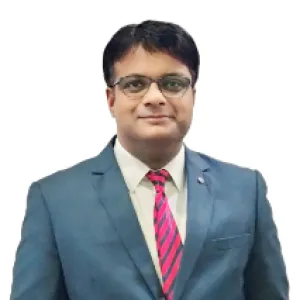Introduction:
- I am Dr. Ubaid Ahmed Nisar, an Assisstant Professor in the Department of Mathematics at NUTECH and having more than 09 years of experience in academia at university level. My research interests are in the computational mathematics and mathematical modeling. The aim of the study is to approximate the solutions of such phenomena numerically in the absence of the exact solutions for obtaining efficient and accurate results.
Experience:
Assistant Professor, Department of Mathematics, NUTECH (Sep 2018 – Present)
- Lead member mathematics
- Designing of mathematics curriculum for engineering and computing departments
- Teach undergraduate and graduate courses of mathematics
- Department coordination officer
- NUET coordinator
- Supervised many ICAT projects related to applications of mathematics
- Serve as a faculty mentor for students
Assistant Professor, Department of Computer Science, Bahria University (Aug 2017 – Sep 2018)
- Teach undergraduate and graduate courses of Mathematics
- Complete funded HEC SRGP Project
Supervised 3x MS Thesis
Visiting Lecturer, Department of Computer Science, Bahria University (Aug 2014 – Aug 2017)
- Teach undergraduate courses of Mathematics
Qualification:
- Academia:
- Ph.D. in Mathematics, COMSATS University, Islamabad, Pakistan (2017)
- MS in Mathematics, COMSATS University, Islamabad, Pakistan (2012)
- BS in Mathematics, COMSATS University, Islamabad, Pakistan (2010)
I have published 14 peer-reviewed papers in top-tier journals, such as Computer Physics Communications, Computational Biology and Chemistry, Computer Methods and Programs in Biomedicine, International Journal of Numerical Methods for Heat & Fluid Flow, Numerical Heat Transfer, Part A: Applications, etc.
- Trainings
- Faculty Development Program, University of UTAH, USA (2019)
- OBE Training, National University of Technology, Pakistan (2020)
- MATLAB EXPO, Ireland, Online (2020)
- MATLAB EXPO, Ireland, Online (2023)
- MATLAB EXPO, Ireland, Online (2024)
I have taught a variety of undergraduate and graduate-level courses in the Engineering and Computing Departments. Below are the courses I have been involved in teaching:
- MATH1105 Applied Calculus
An introductory course focusing on fundamental concepts of calculus for Civil Engineers.
- MATH2303 Applied Differential Equations
An introductory course focusing on fundamental concepts of differential equations and theirs solutions.
- MATH1103 Calculus and Analytical Geometry
An introductory course focusing on fundamental concepts of calculus for Computer Science students.
- MATH1104 Calculus I
An introductory course focusing on fundamental concepts of calculus for Mechanical Engineers.
- MATH1107 Calculus II
An advance course focusing on concepts of multi-variable calculus for Mechanical Engineers.
- MATH2305 Differential Equations and Linear Algebra
A course of blended mixture of differential equations and linear algebra for better understanding of complex problems arising in the field of engineering and study of their solutions.
- ME3505 Numerical Analysis
A computational course for solving the non-linear problems of engineering numerically. Introduction to FDM, FEM & FVM is also part of this course.
- ME3506 Numerical Analysis Lab
Lab course deals with the computationally implementation of Numerical Analysis topics with the help of MATLAB.
Research
My research interests are in the modeling and simulation of the various physical phenomena. The aim of the study is to approximate the solutions of such phenomena numerically in the absence of the exact solutions. I have studied the various models from Physics, Chemistry and Biology. Few of the studies include modeling & simulation of Multi-Physics Systems, e.g. Hydro-dynamical Model for Semiconductor Devices in which we predict the quality of semiconductor material depending on the various parameter to develop high-speed computer, navigation systems, digital watches etc. In Chemical Engineering, I studied the Population Balance Models which deal with the Batch and Coupled Crystallization. In Computational Biology study of the Cancer Growth Models were studied.
- Publications:
- Ubaid., et al. (2024). “A computational analysis on two phase Eyring-Powell (non-Newtonian) dust particles flow for heat and mass transfer phenomenon with variable thermal features.” Numerical Heat Transfer, Part A: Applications.
- Ubaid., et al. (2023). “Numerical study and mathematical modeling of cancer growth using finite element method.” Mathematical Biosciences.
- Ubaid., et al. (2023). “Numerical approximation of cancer growth models.” Journal of Mathematical Biology.
- Ubaid., et al. (2022). “On Starlike Functions of Negative Order Defined by q-Fractional Derivative.” Fractal and Fractional.
- Ubaid., et al. (2021). “A non-linear mathematical analysis of thermally radiative stratified nanoliquid featuring the aspects of magnetic field, Robin conditions and thermal radiation.” International Communications in Heat and Mass Transfer.
- Ubaid., et al. (2021). “Rheology of hydromagnetic viscoelastic fluid subjected to dissipation aspect.” International Journal of Numerical Methods for Heat & Fluid Flow.
- Ubaid., et al. (2020). “Evaluating the characteristics of magnetic dipole for shear-thinning Williamson nanofluid with thermal radiation.” Computer Methods and Programs in Biomedicine.
- Ubaid., et al. (2020). “Space-time CE/SE method for solving repulsive chemotaxis model.” SN Applied Sciences.
- Ubaid., et al. (2019). “Kinetic flux vector splitting scheme for solving non-reactive multi-component flows.” Computational Biology and Chemistry.
- Ubaid., et al. (2019). “Discontinuous Galerkin method for solving incompressible two-phase shallow granular flow model.” Advances in Mechanical Engineering.
- Ubaid., et al. (2018). “Application of kinetic flux vector splitting scheme for solving viscous quantum hydrodynamical model of semiconductor devices.” Results in physics.
- Ubaid., et al. (2017). “Application of kinetic flux vector splitting scheme for solving multi-dimensional hydrodynamical models of semiconductor devices.” Results in physics.
- Ubaid., et al. (2016). “A splitting scheme based on the space–time CE/SE method for solving multi-dimensional hydrodynamical models of semiconductor devices.” Computer Physics Communications.
Projects:
- Modelling and Simulation of Viscous-Quantum- Hydrodynamical Models in Semiconductor Devices (2017 – 2018)
- Modeling and Simulation of the Novel Coronavirus (2019 – nCov) in Pakistan
